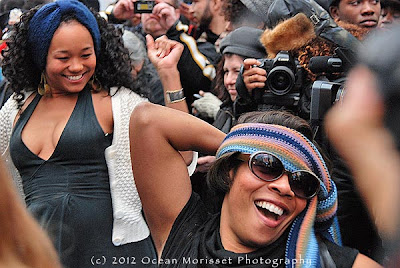
Today I visited the Jewish Museum in New York City for an extraordinary exhibition titled
The Radical Camera, images by New York’s Photo League 1936-1951. I must admit, though I’m an avid museum goer, I never visited this beautiful museum located just across the street from Central Park at 92nd street. After clearing security and walking through a metal detector, I walked passed an army of small Jewish children on a school tour and approached the reception desk to pay the $12 fee. The Asian cashier who seemed altogether pleased and relieved to see me, a black man, suggested I become a member of the Jewish Museum. Sensing my hesitation and without missing a beat, she tried hard to sell me the membership by announcing that painter extraordinaire,
Kehinde Wiley will have works on view in March and rattled off a couple of other names of African American Impressionist’s whose names were unfamiliar, and escape me at the moment. I thought it was a good sell, and while I will be back to see Kehinde’s exhibition, I declined the invitation to become a member (for now).
I entered the exhibition space and was struck by a sense of New York history almost immediately. I read and studied the photographs and information as if I was getting a pop-quiz the following day. As a photographer, being at this exhibition was like being a kid in a candy store. There were so many photographs well spaced and positioned; all of them rich, fine gelatin silver prints by such notable photographers like: Aaron Siskind, Berenice Abbott, Paul Strand, Arnold Newman, Lisette Model, Helen Levitt, W. Eugene Smith, Vivian Cherry, Lucy Ashjian, and others whose work I had only come to learn about like Eliot Elisofon, Joe Schwartz, Lewis Wickes Hine, and Morris Engel. I also became familiar with the work of Harold Corsini who viewed documentary photography as honest and unmediated. He believed that a “true” and “good” picture was one in which aesthetic qualities did not overwhelm the context or subvert its message. As it relates to documentary photography, I couldn’t agree more.
 Playing football by Harold Corsini
Playing football by Harold Corsini Buuterfly boy, by Jerome Liebling
Buuterfly boy, by Jerome LieblingAll of these Jewish-American photographer’s were members of New York’s Photo League whose solidarity centered in the belief in the expressive power of documentary photography and on a progressive alliance in the thirties of socialist ideas. Leading member Sid Grossman pushed students to discover not only the meaning of their work, but also their relationship to it...a philosophy I personally and firmly believe in.
 Zito's Bakery, by Berenice Abbot
Zito's Bakery, by Berenice AbbotMost of the images created during the period of 1936 to the late 1940’s by the New York Photo League contained within them a social narrative and aesthetic. It was indeed social-minded photography as depicted in Eliot Elisofon’s
WPA cleaned this area, Keep it Clean (1940) and Vivian Cherry’s startling
Game of Lynching(1947). The introduction of small hand-held cameras around this time enabled this new kind of chance photography, at once casual and purposeful. Each image would serve as a powerful document, recording signs of the times from Great Depression, to the War Years. An interesting part of the exhibition was the Harlem Document, 1936-1940 which was a project led by photographer Aaron Siskind. The Harlem Document’s goal was to provide evidence of an impoverished community in peril and advocate for improvement of its living conditions. Any photographer who has followed the work of Siskind knows that his intentions blew up miserably in his face, as many images (not all) that I’ve seen from this period portrayed a stereotypical view of Harlem, and a negative portrayal of African-Americans. To paraphrase Siskind:
“There was so much good going on in Harlem that we could have shown, but we never had an opportunity to show it.” The images on display from the Harlem Document were benign in my opinion and I didn’t see anything offensive in them, though they were beautifully printed. I guess the museum curators thought better of inciting a riot!
 Wishing Tree by Aaron Siskind
Wishing Tree by Aaron Siskind Game of Lynching by Vivian Cherry
Game of Lynching by Vivian CherryBesides original photographs, the exhibition also included original newspapers and articles from the New York Times, Life Magazine as well as the New York Photo League’s official publication titled
Photo Notes. The exhibition ended nicely (and leaving me wanting more) with a documentary film about the New York Photo League called
Ordinary Miracles. See the video below.
I left the exhibition feeling inspired, ready to see the world and reflecting on my own bearing in it.
If you haven’t yet seen this exhibition and you are anywhere in the tri-state area, I highly recommended a visit to the Jewish Museum. The exhibition is up until March 25, 2012. For more information, follow this link: http://www.thejewishmuseum.org/exhibitions/photoleague
“The thing that shocks me and which I really try to change is the lukewarmness, the indifference, the kind of taking pictures that really doesn’t matter.” –Lisette Model

















































